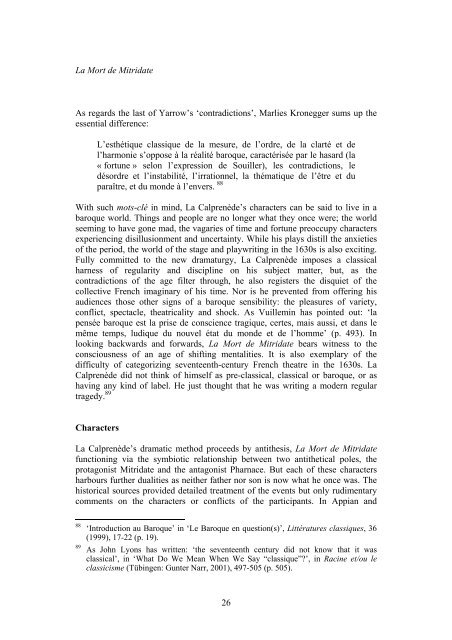LA MORT DE MITRIDATE - University of Liverpool
LA MORT DE MITRIDATE - University of Liverpool
LA MORT DE MITRIDATE - University of Liverpool
You also want an ePaper? Increase the reach of your titles
YUMPU automatically turns print PDFs into web optimized ePapers that Google loves.
La Mort de Mitridate<br />
As regards the last <strong>of</strong> Yarrow’s ‘contradictions’, Marlies Kronegger sums up the<br />
essential difference:<br />
L’esthétique classique de la mesure, de l’ordre, de la clarté et de<br />
l’harmonie s’oppose à la réalité baroque, caractérisée par le hasard (la<br />
« fortune » selon l’expression de Souiller), les contradictions, le<br />
désordre et l’instabilité, l’irrationnel, la thématique de l’être et du<br />
paraître, et du monde à l’envers. 88<br />
With such mots-clé in mind, La Calprenède’s characters can be said to live in a<br />
baroque world. Things and people are no longer what they once were; the world<br />
seeming to have gone mad, the vagaries <strong>of</strong> time and fortune preoccupy characters<br />
experiencing disillusionment and uncertainty. While his plays distill the anxieties<br />
<strong>of</strong> the period, the world <strong>of</strong> the stage and playwriting in the 1630s is also exciting.<br />
Fully committed to the new dramaturgy, La Calprenède imposes a classical<br />
harness <strong>of</strong> regularity and discipline on his subject matter, but, as the<br />
contradictions <strong>of</strong> the age filter through, he also registers the disquiet <strong>of</strong> the<br />
collective French imaginary <strong>of</strong> his time. Nor is he prevented from <strong>of</strong>fering his<br />
audiences those other signs <strong>of</strong> a baroque sensibility: the pleasures <strong>of</strong> variety,<br />
conflict, spectacle, theatricality and shock. As Vuillemin has pointed out: ‘la<br />
pensée baroque est la prise de conscience tragique, certes, mais aussi, et dans le<br />
même temps, ludique du nouvel état du monde et de l’homme’ (p. 493). In<br />
looking backwards and forwards, La Mort de Mitridate bears witness to the<br />
consciousness <strong>of</strong> an age <strong>of</strong> shifting mentalities. It is also exemplary <strong>of</strong> the<br />
difficulty <strong>of</strong> categorizing seventeenth-century French theatre in the 1630s. La<br />
Calprenède did not think <strong>of</strong> himself as pre-classical, classical or baroque, or as<br />
having any kind <strong>of</strong> label. He just thought that he was writing a modern regular<br />
tragedy. 89<br />
Characters<br />
La Calprenède’s dramatic method proceeds by antithesis, La Mort de Mitridate<br />
functioning via the symbiotic relationship between two antithetical poles, the<br />
protagonist Mitridate and the antagonist Pharnace. But each <strong>of</strong> these characters<br />
harbours further dualities as neither father nor son is now what he once was. The<br />
historical sources provided detailed treatment <strong>of</strong> the events but only rudimentary<br />
comments on the characters or conflicts <strong>of</strong> the participants. In Appian and<br />
88<br />
89<br />
‘Introduction au Baroque’ in ‘Le Baroque en question(s)’, Littératures classiques, 36<br />
(1999), 17-22 (p. 19).<br />
As John Lyons has written: ‘the seventeenth century did not know that it was<br />
classical’, in ‘What Do We Mean When We Say “classique”?’, in Racine et/ou le<br />
classicisme (Tübingen: Gunter Narr, 2001), 497-505 (p. 505).<br />
26
















